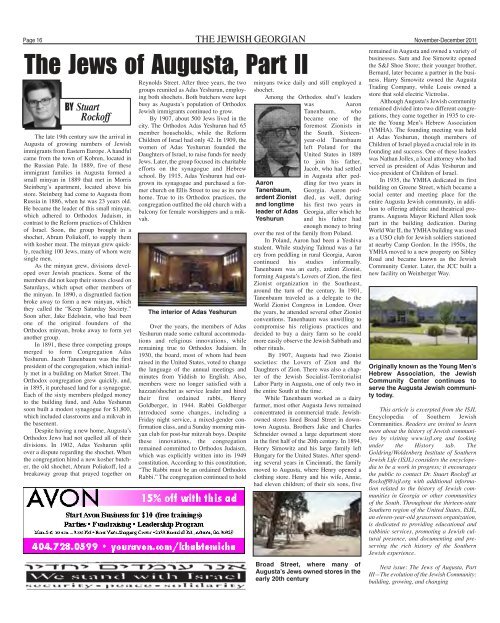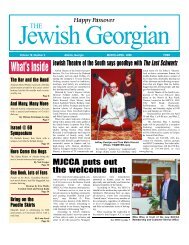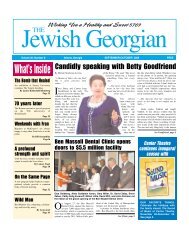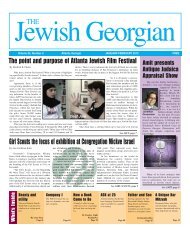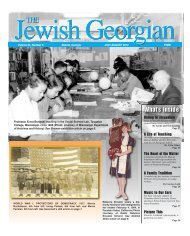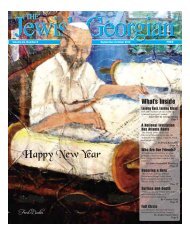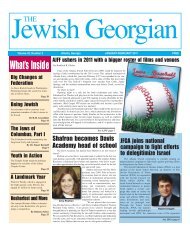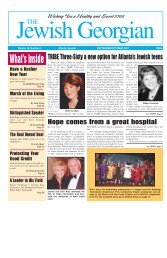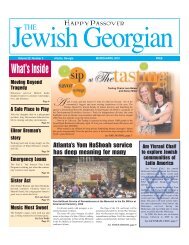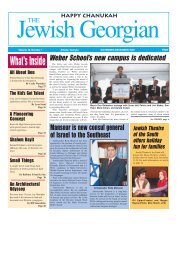Happy Chanukah - The Jewish Georgian
Happy Chanukah - The Jewish Georgian
Happy Chanukah - The Jewish Georgian
Create successful ePaper yourself
Turn your PDF publications into a flip-book with our unique Google optimized e-Paper software.
Page 16 THE JEWISH GEORGIAN November-December 2011<br />
<strong>The</strong> Jews of Augusta, Part II<br />
BY<br />
Stuart<br />
Rockoff<br />
<strong>The</strong> late 19th century saw the arrival in<br />
Augusta of growing numbers of <strong>Jewish</strong><br />
immigrants from Eastern Europe. A handful<br />
came from the town of Kobren, located in<br />
the Russian Pale. In 1889, five of these<br />
immigrant families in Augusta formed a<br />
small minyan in 1889 that met in Morris<br />
Steinberg’s apartment, located above his<br />
store. Steinberg had come to Augusta from<br />
Russia in 1886, when he was 23 years old.<br />
He became the leader of this small minyan,<br />
which adhered to Orthodox Judaism, in<br />
contrast to the Reform practices of Children<br />
of Israel. Soon, the group brought in a<br />
shochet, Abram Poliakoff, to supply them<br />
with kosher meat. <strong>The</strong> minyan grew quickly,<br />
reaching 100 Jews, many of whom were<br />
single men.<br />
As the minyan grew, divisions developed<br />
over <strong>Jewish</strong> practices. Some of the<br />
members did not keep their stores closed on<br />
Saturdays, which upset other members of<br />
the minyan. In 1890, a disgruntled faction<br />
broke away to form a new minyan, which<br />
they called the “Keep Saturday Society.”<br />
Soon after, Jake Edelstein, who had been<br />
one of the original founders of the<br />
Orthodox minyan, broke away to form yet<br />
another group.<br />
In 1891, these three competing groups<br />
merged to form Congregation Adas<br />
Yeshurun. Jacob Tanenbaum was the first<br />
president of the congregation, which initially<br />
met in a building on Market Street. <strong>The</strong><br />
Orthodox congregation grew quickly, and,<br />
in 1895, it purchased land for a synagogue.<br />
Each of the sixty members pledged money<br />
to the building fund, and Adas Yeshurun<br />
soon built a modest synagogue for $1,800,<br />
which included classrooms and a mikvah in<br />
the basement.<br />
Despite having a new home, Augusta’s<br />
Orthodox Jews had not quelled all of their<br />
divisions. In 1902, Adas Yeshurun split<br />
over a dispute regarding the shochet. When<br />
the congregation hired a new kosher butcher,<br />
the old shochet, Abram Poliakoff, led a<br />
breakaway group that prayed together on<br />
Reynolds Street. After three years, the two<br />
groups reunited as Adas Yeshurun, employing<br />
both shochets. Both butchers were kept<br />
busy as Augusta’s population of Orthodox<br />
<strong>Jewish</strong> immigrants continued to grow.<br />
By 1907, about 500 Jews lived in the<br />
city. <strong>The</strong> Orthodox Adas Yeshurun had 65<br />
member households, while the Reform<br />
Children of Israel had only 42. In 1909, the<br />
women of Adas Yeshurun founded the<br />
Daughters of Israel, to raise funds for needy<br />
Jews. Later, the group focused its charitable<br />
efforts on the synagogue and Hebrew<br />
school. By 1915, Adas Yeshurun had outgrown<br />
its synagogue and purchased a former<br />
church on Ellis Street to use as its new<br />
home. True to its Orthodox practices, the<br />
congregation outfitted the old church with a<br />
balcony for female worshippers and a mikvah.<br />
<strong>The</strong> interior of Adas Yeshurun<br />
Over the years, the members of Adas<br />
Yeshurun made some cultural accommodations<br />
and religious innovations, while<br />
remaining true to Orthodox Judaism. In<br />
1930, the board, most of whom had been<br />
raised in the United States, voted to change<br />
the language of the annual meetings and<br />
minutes from Yiddish to English. Also,<br />
members were no longer satisfied with a<br />
hazzan/shochet as service leader and hired<br />
their first ordained rabbi, Henry<br />
Goldberger, in 1944. Rabbi Goldberger<br />
introduced some changes, including a<br />
Friday night service, a mixed-gender confirmation<br />
class, and a Sunday morning minyan<br />
club for post-bar mitzvah boys. Despite<br />
these innovations, the congregation<br />
remained committed to Orthodox Judaism,<br />
which was explicitly written into its 1949<br />
constitution. According to this constitution,<br />
“<strong>The</strong> Rabbi must be an ordained Orthodox<br />
Rabbi.” <strong>The</strong> congregation continued to hold<br />
minyans twice daily and still employed a<br />
shochet.<br />
Among the Orthodox shul’s leaders<br />
was Aaron<br />
Tanenbaum, who<br />
became one of the<br />
foremost Zionists in<br />
the South. Sixteenyear-old<br />
Tanenbaum<br />
left Poland for the<br />
United States in 1889<br />
to join his father,<br />
Jacob, who had settled<br />
Aaron<br />
Tanenbaum,<br />
ardent Zionist<br />
and longtime<br />
leader of Adas<br />
Yeshurun<br />
in Augusta after peddling<br />
for two years in<br />
Georgia. Aaron peddled,<br />
as well, during<br />
his first two years in<br />
Georgia, after which he<br />
and his father had<br />
enough money to bring<br />
over the rest of the family from Poland.<br />
In Poland, Aaron had been a Yeshiva<br />
student. While studying Talmud was a far<br />
cry from peddling in rural Georgia, Aaron<br />
continued his studies informally.<br />
Tanenbaum was an early, ardent Zionist,<br />
forming Augusta’s Lovers of Zion, the first<br />
Zionist organization in the Southeast,<br />
around the turn of the century. In 1901,<br />
Tanenbaum traveled as a delegate to the<br />
World Zionist Congress in London. Over<br />
the years, he attended several other Zionist<br />
conventions. Tanenbaum was unwilling to<br />
compromise his religious practices and<br />
decided to buy a dairy farm so he could<br />
more easily observe the <strong>Jewish</strong> Sabbath and<br />
other rituals.<br />
By 1907, Augusta had two Zionist<br />
societies: the Lovers of Zion and the<br />
Daughters of Zion. <strong>The</strong>re was also a chapter<br />
of the <strong>Jewish</strong> Socialist-Territorialist<br />
Labor Party in Augusta, one of only two in<br />
the entire South at the time.<br />
While Tanenbaum worked as a dairy<br />
farmer, most other Augusta Jews remained<br />
concentrated in commercial trade. <strong>Jewish</strong>owned<br />
stores lined Broad Street in downtown<br />
Augusta. Brothers Jake and Charles<br />
Schneider owned a large department store<br />
in the first half of the 20th century. In 1894,<br />
Henry Simowitz and his large family left<br />
Hungary for the United States. After spending<br />
several years in Cincinnati, the family<br />
moved to Augusta, where Henry opened a<br />
clothing store. Henry and his wife, Annie,<br />
had eleven children; of their six sons, five<br />
Broad Street, where many of<br />
Augustaʼs Jews owned stores in the<br />
early 20th century<br />
remained in Augusta and owned a variety of<br />
businesses. Sam and Joe Simowitz opened<br />
the S&J Shoe Store; their younger brother,<br />
Bernard, later became a partner in the business.<br />
Harry Simowitz owned the Augusta<br />
Trading Company, while Louis owned a<br />
store that sold electric Victrolas.<br />
Although Augusta’s <strong>Jewish</strong> community<br />
remained divided into two different congregations,<br />
they came together in 1935 to create<br />
the Young Men’s Hebrew Association<br />
(YMHA). <strong>The</strong> founding meeting was held<br />
at Adas Yeshurun, though members of<br />
Children of Israel played a crucial role in its<br />
founding and success. One of these leaders<br />
was Nathan Jolles, a local attorney who had<br />
served as president of Adas Yeshurun and<br />
vice-president of Children of Israel.<br />
In 1935, the YMHA dedicated its first<br />
building on Greene Street, which became a<br />
social center and meeting place for the<br />
entire Augusta <strong>Jewish</strong> community, in addition<br />
to offering athletic and theatrical programs.<br />
Augusta Mayor Richard Allen took<br />
part in the building dedication. During<br />
World War II, the YMHA building was used<br />
as a USO club for <strong>Jewish</strong> soldiers stationed<br />
at nearby Camp Gordon. In the 1950s, the<br />
YMHA moved to a new property on Sibley<br />
Road and became known as the <strong>Jewish</strong><br />
Community Center. Later, the JCC built a<br />
new facility on Weinberger Way.<br />
Originally known as the Young Menʼs<br />
Hebrew Association, the <strong>Jewish</strong><br />
Community Center continues to<br />
serve the Augusta <strong>Jewish</strong> community<br />
today.<br />
This article is excerpted from the ISJL<br />
Encyclopedia of Southern <strong>Jewish</strong><br />
Communities. Readers are invited to learn<br />
more about the history of <strong>Jewish</strong> communities<br />
by visiting www.isjl.org and looking<br />
under the History tab. <strong>The</strong><br />
Goldring/Woldenberg Institute of Southern<br />
<strong>Jewish</strong> Life (ISJL) considers the encyclopedia<br />
to be a work in progress; it encourages<br />
the public to contact Dr. Stuart Rockoff at<br />
Rockoff@isjl.org with additional information<br />
related to the history of <strong>Jewish</strong> communities<br />
in Georgia or other communities<br />
of the South. Throughout the thirteen-state<br />
Southern region of the United States, ISJL,<br />
an eleven-year-old grassroots organization,<br />
is dedicated to providing educational and<br />
rabbinic services, promoting a <strong>Jewish</strong> cultural<br />
presence, and documenting and preserving<br />
the rich history of the Southern<br />
<strong>Jewish</strong> experience.<br />
Next issue: <strong>The</strong> Jews of Augusta, Part<br />
III—<strong>The</strong> evolution of the <strong>Jewish</strong> Community:<br />
building, growing, and changing


